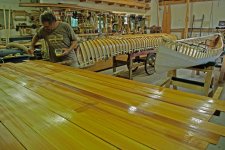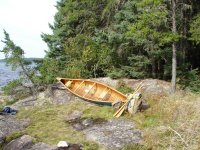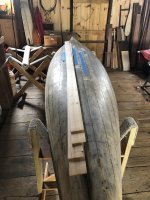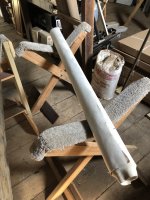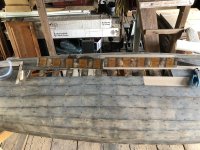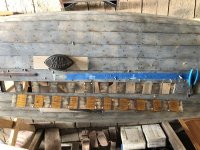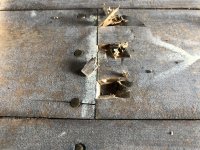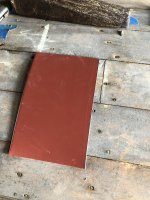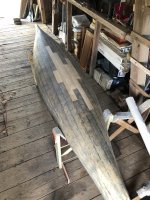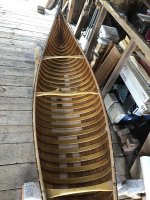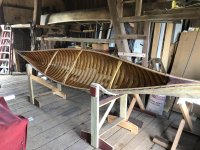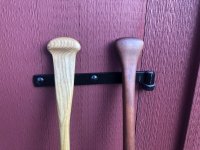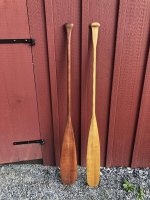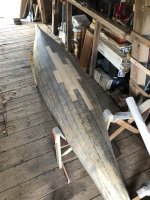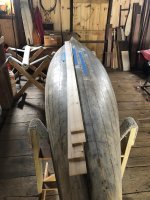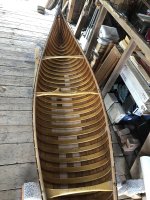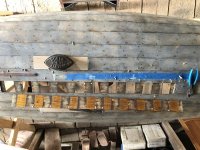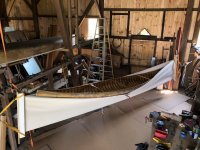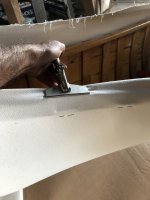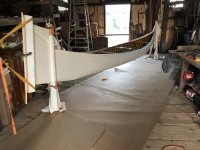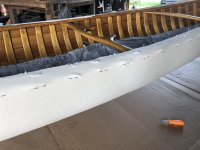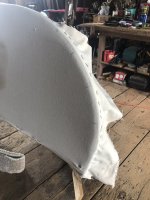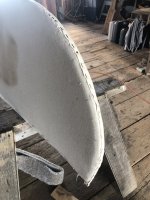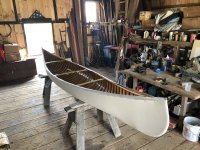The (new to me) 15' Willow restoration has begun. Mahogany outwales have been removed, all the good planks have had their tacks re-clinched where necessary, filler residue has been either scraped off or sanded, quarter thwarts removed for sanding and new varnish. Al Bratton at Woodstrip Watercraft is making 24' of new 1/8" eastern white cedar planking for repairs to the bottom planks, and he will provide #10 canvas for the new skin and new brass stem bands. I decided on #10 instead of lighter #12 or dacron in order to add a little durability as well as keep the outer surface as fair as possible. This canoe will not be a sawhorse queen; she'll be a tripping boat for the little ponds of the ADK's for sure.
The many canvas overlap tack holes in the stems were filled by a little dab of Elmer's glue and a round toothpick inserted. Not jammed tight, just snug. Once cured the excess was trimmed and sanded. It'll provide a more consistent surface for new tacks and stem band screws.
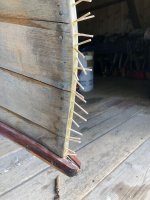
Here are two shots of the Willow on the left, and my current daily paddler on the right. Same length, 15'. The Willow is 2" wider, but way less full in the bow quarters- much finer entry, and as a whole much lighter built. Without the skin & paint... maybe weighs 40#.

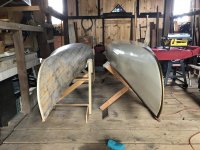
To the chagrin of some, I did lop off the extended inwales (which were pretty beat up) and sanded back to flush with the outer stem. Once re-canvassed I will extend the brass stem band up and onto the deck, and the outwales will be tapered and faired into the rear edge of the stem band on each side. These photos aren't of the same stem, but serve to illustrate the before and after. To explain my thinking... this canoe is neither a historic canoe, nor was it actually built by the designer Jerry Stelmok at his shop Island Falls Canoe. Ultimately, it's like any restoration of a posession- it's what made sense to me, and improves the utility and, more importantly, durability for real world use.
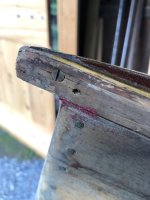
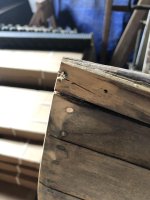
Lastly, Al is making me a paddle of his own design, the JBS blade in Sassafras wood. Sassafras grows locally and as a kid on the farm, we used to pull the young roots and make sassafras tea. It's also the flavoring for original root beer I think. The idea of Sassafras for a paddle just appealed to me! In the following picture, it'll be just like the one on the rack two paddles to the left of the dark cherry one. Here's his paddle page: http://www.woodstrip.wcha.org/paddle-order-form.pdf. It should be a good deep water blade, quite narrow and the blade is roughly equal to the shaft length. Very lightweight and flexible, but quite durable apparently. His Herreschoff double blades on the right of the rack are beautiful as well. He makes very nice paddles!

The mailman just delivered 1/2" planking tacks, stem band screws, and new seat bolts from Northwoods Canoe in Maine. I'm anxious to get moving so I can get this canoe in the water in late Fall!
The many canvas overlap tack holes in the stems were filled by a little dab of Elmer's glue and a round toothpick inserted. Not jammed tight, just snug. Once cured the excess was trimmed and sanded. It'll provide a more consistent surface for new tacks and stem band screws.

Here are two shots of the Willow on the left, and my current daily paddler on the right. Same length, 15'. The Willow is 2" wider, but way less full in the bow quarters- much finer entry, and as a whole much lighter built. Without the skin & paint... maybe weighs 40#.


To the chagrin of some, I did lop off the extended inwales (which were pretty beat up) and sanded back to flush with the outer stem. Once re-canvassed I will extend the brass stem band up and onto the deck, and the outwales will be tapered and faired into the rear edge of the stem band on each side. These photos aren't of the same stem, but serve to illustrate the before and after. To explain my thinking... this canoe is neither a historic canoe, nor was it actually built by the designer Jerry Stelmok at his shop Island Falls Canoe. Ultimately, it's like any restoration of a posession- it's what made sense to me, and improves the utility and, more importantly, durability for real world use.


Lastly, Al is making me a paddle of his own design, the JBS blade in Sassafras wood. Sassafras grows locally and as a kid on the farm, we used to pull the young roots and make sassafras tea. It's also the flavoring for original root beer I think. The idea of Sassafras for a paddle just appealed to me! In the following picture, it'll be just like the one on the rack two paddles to the left of the dark cherry one. Here's his paddle page: http://www.woodstrip.wcha.org/paddle-order-form.pdf. It should be a good deep water blade, quite narrow and the blade is roughly equal to the shaft length. Very lightweight and flexible, but quite durable apparently. His Herreschoff double blades on the right of the rack are beautiful as well. He makes very nice paddles!

The mailman just delivered 1/2" planking tacks, stem band screws, and new seat bolts from Northwoods Canoe in Maine. I'm anxious to get moving so I can get this canoe in the water in late Fall!

